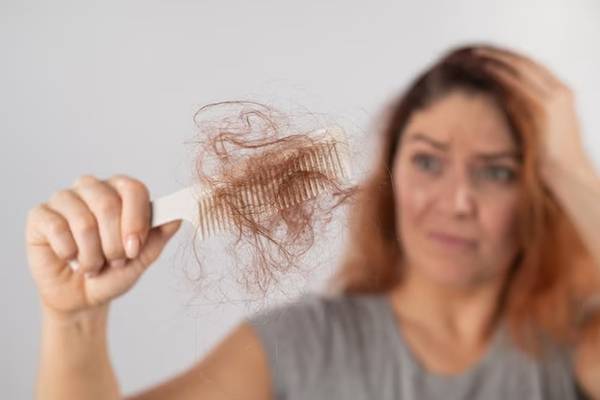Hair loss, or alopecia, is a condition that affects millions of people of all ages. Its causes vary, from lifestyle habits to genetic and hormonal factors that accelerate hair loss.
Conventional hair loss treatments, such as hair care products, masks, and vitamins, are effective for mild cases of alopecia. However, in more severe cases, effective and safe therapies that stimulate and regenerate hair follicles are necessary.
Let’s take a closer look at alopecia and the latest hair loss treatments available.
What is Alopecia?
Alopecia is a condition characterized by abnormal hair loss. On average, people lose between 50 and 100 hairs per day as part of the natural hair renewal process. However, when hair loss exceeds this amount and persists, it is considered alopecia.
There are two main types of alopecia: scarring and non-scarring. Scarring alopecia destroys hair follicles, making baldness irreversible. In contrast, non-scarring alopecia does not leave scars or fibrous tissue, allowing lost hair to regrow.
Causes of Hair Loss
Hair growth follows three phases:
- Anagen phase: The growth phase where hair increases about one centimeter per month, lasting between one and four years. This phase involves follicle regeneration for hair production.
- Catagen phase: A transitional phase where hair production stops and the follicle retracts from the scalp’s surface, lasting one to three weeks.
- Telogen phase: The resting or shedding phase where hair remains attached to the follicle for a few months before falling out.
While hair naturally falls out during the telogen phase, excessive hair loss can result from:
Genetics
Androgenic alopecia, or male pattern baldness, occurs when hair follicles shrink due to androgen hormones, particularly dihydrotestosterone (DHT). This condition leads to finer, shorter hair and a receding hairline. Although more common in men, women can also experience it.
Hormonal Changes
Hormonal fluctuations, such as those occurring postpartum, can trigger significant hair loss.
Environmental Factors
Exposure to pollutants, cigarette smoke, environmental toxins, and UV rays can weaken hair and increase shedding.
Medical Conditions
Autoimmune diseases, scalp infections, or scarring alopecia can lead to uneven hair loss and follicular damage.
Lifestyle Factors
Stress, fatigue, poor nutrition, inadequate hygiene, excessive heat styling, and tight hairstyles can weaken hair and accelerate loss.

Diagnosing Hair Loss
Proper diagnosis of hair loss requires a comprehensive evaluation to determine its underlying causes. Dermatologists or trichologists specialize in diagnosing hair loss, although a general physician can also conduct preliminary tests.
Common diagnostic methods include:
- Medical History: A specialist gathers information on family history, general health, medications, diet, and hair care routine.
- Physical Examination: The scalp is inspected for thinning areas, hair loss patterns, or skin changes.
- Pull Test: The doctor gently pulls a small amount of hair to assess shedding severity.
- Blood Tests: These tests help identify underlying medical conditions like nutritional deficiencies, hormonal imbalances, or autoimmune diseases.
- Scalp Biopsy: If a scalp disease is suspected, a biopsy may be necessary to analyze a tissue sample under a microscope.
- Trichoscopy: A microscopic scalp and hair examination to evaluate follicular health.
- Phototrichogram: A test that assesses hair growth, determining the ratio of anagen (growth) to telogen (shedding) phases.
Hair Loss Treatment Options
In recent years, new hair loss treatments have been developed, offering promising and long-lasting results. The most effective treatments include:
Hair Care Products
Hair care products such as shampoos, conditioners, masks, and ampoules help strengthen hair and reduce shedding. However, these products primarily cleanse the scalp, prevent grease buildup, and detangle hair.
Products containing active ingredients like minoxidil are particularly effective in stimulating existing hair follicles. Continuous use for at least six months is recommended, under medical supervision, as stopping treatment may halt hair regrowth.
Minoxidil-based products are available as shampoos, foams, and scalp lotions.
Hair Transplant
Hair transplantation is a permanent solution to hair loss. This procedure involves extracting healthy hair follicles from the patient’s scalp and relocating them to bald areas. Since the follicles come from the patient, rejection risks are minimal, and results appear natural.
However, the procedure requires sufficient donor hair and may leave small scars at the extraction site. Additionally, results become visible after several months.
Stem Cell Therapy
Stem cell therapy for hair loss is a regenerative medicine technique that stimulates hair regrowth by revitalizing dormant follicles through the use of allogeneic stem cells, meaning those derived from a donor.
The properties of these donated stem cells may also help modulate autoimmune conditions affecting the scalp.
Low-Level Laser Therapy (LLLT)
Low-level laser therapy is a non-invasive treatment that uses low-intensity laser light to improve blood circulation in the scalp. It is recommended for androgenic, diffuse, and areata alopecia, with visible results after three sessions.
Beyond reducing hair loss, patients often notice denser, stronger, and healthier hair.
Platelet-Rich Plasma (PRP) Therapy
PRP is an innovative treatment that uses the patient’s own blood-derived growth factors. The process involves drawing a blood sample, centrifuging it to concentrate platelets, and injecting them into the scalp via microinjections.
This therapy enhances hair vitality, increases volume, and improves scalp blood circulation, making it suitable for various alopecia types.
Mesotherapy
Similar to PRP, mesotherapy involves injecting growth factors into the scalp, but also includes vitamins, amino acids, trace elements, and vasodilators.
Both treatments require multiple sessions, with visible results typically appearing after four months.
Medications for Hair Loss
Several medications effectively treat hair loss:
Minoxidil
This medication increases blood circulation to hair follicles, enhancing their size and hair strand thickness. It is FDA-approved for androgenic alopecia in both men and women.
Finasteride
This oral medication blocks 5-alpha reductase, an enzyme that converts testosterone into DHT, which is linked to hair follicle shrinkage. Prescribed mainly for male pattern baldness, finasteride requires medical supervision due to potential side effects such as reduced libido and erectile dysfunction.
Corticosteroids
Used for alopecia areata, corticosteroids reduce scalp inflammation and help reactivate dormant follicles.
Anthralin
A tar-derived cream used to treat alopecia areata by eliminating scaly patches.
Benefits of Advanced Hair Loss Therapies
Hair loss can impact self-esteem and confidence, but innovative treatments offer long-lasting, effective solutions that address its root causes.
Benefits of modern hair loss therapies include:
- Slowing alopecia progression
- Preserving existing hair and stimulating new growth
- Promoting follicle regeneration
- Increasing hair density and thickness
- Nourishing the scalp
- Improving hair texture and shine
- Delivering natural, long-lasting results
- Restoring self-confidence
Stem Cell Therapy: A Comprehensive Solution for Hair Health
Stem cell therapy is one of the treatments capable of triggering the self-repair mechanisms of hair follicles damaged by alopecia. It regenerates follicles, promoting the natural growth of new, healthy hair.
Additionally, stem cell therapy addresses the underlying causes of hair loss, such as autoimmune disorders and follicular miniaturization, providing long-lasting benefits beyond improved hair density.
At CRC, we offer stem cell therapy for hair loss to help restore hair health and density with an innovative treatment that delivers outstanding results.

Hair Restoration Treatment Protocol with Stem Cells at CRC
Stem cell treatment is one of the most innovative in hair restoration and hair loss prevention, as it combines the regenerative capacity of stem cells with growth factors and exosomes that strengthen the hair structure.
At CRC, we developed a stem cell application protocol for the treatment of hair loss. This consists of the application of three active agents: stem cells that regenerate, vascularize, and strengthen follicles; exosomes; and growth factors that contribute to hair growth, restoration, and regeneration.
In addition, this process stimulates the formation of collagen, elastin, and hyaluronic acid, which makes the results faster, longer-lasting, and more visible. These results are:
- Thicker hair
- Stronger hair follicles
- Healthier, and silkier hair
Who are candidates for hair restoration treatment with stem cells?
Men and women, regardless of their age, can receive stem cell treatment for hair loss. They can even undergo it before a hair transplant to increase the survival of the implants. In any case, it is essential to visit CRC for a consultation to diagnose the type of alopecia, genetic or lifestyle factors causing hair loss, and to determine the recommended sessions to achieve satisfactory results.
How are stem cells applied for hair restoration?
The application of stem cells requires a combination of a derma roller and microinjections. Before the session, a special cream is applied to numb the area where the microinjections will be performed, through which the combination of active ingredients in serum is applied.
After this session, the patient can return for growth factors and exosomes for better results.
How long does it take to see results?
The results of stem cells for hair restoration vary from patient to patient, just as with any medical procedure. In general, results can take several months, depending on the hair growth stages.
What care should be taken after a hair restoration procedure with stem cells?
At the end of the session, you will be given instructions such as:
- Do not touch or massage the treated area.
- Do not use a cap, gel, or chemical products.
- Protect your head with an umbrella to avoid direct sunlight.
If you’re looking for additional treatments, CRC also offers advanced stem cell therapies, including stem cell for knees, stem cell back treatment, stem cell joint therapy, and stem cell shoulder therapy. Explore all our services and discover how our treatments can help improve your health and well-being.
Book a consultation at CRC today—our specialists are ready to provide the most suitable treatment for your needs!
Sources:
https://www.idermic.es/es/caida-del-cabello-causas-diagnostico-y-tratamientos/
https://www.tucanaldesalud.es/es/tecnologia/articulos/plasma-rico-plaquetas-calvicie-realiza
https://www.idermic.es/es/caida-del-cabello-causas-diagnostico-y-tratamientos/
https://www.mayoclinic.org/es/diseases-conditions/hair-loss/diagnosis-treatment/drc-20372932
https://medlineplus.gov/spanish/druginfo/meds/a698016-es.html


